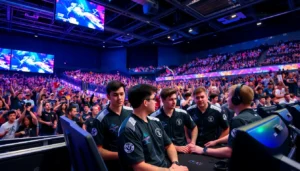Table of Contents
ToggleIn a world where gaming never sleeps, battery-powered consoles are the unsung heroes of portable play. Imagine being able to dive into epic adventures without the pesky cords tethering you down. Whether it’s a long road trip or a cozy afternoon on the couch, these consoles promise freedom with every charge.
Overview of Battery-Powered Consoles
Battery-powered consoles provide a unique gaming experience by enabling mobility and convenience. These devices offer flexibility, allowing users to play games anywhere without the encumbrance of cords. Many models feature robust battery life, ranging from 5 to 15 hours, depending on usage and specifications.
Key advantages include lightweight designs and ergonomic layouts that enhance comfort during extended play sessions. Several popular options, such as the Nintendo Switch and gaming handhelds from Atari or Sega, cater to diverse gaming preferences. These systems support a wide variety of games, appealing to casual and dedicated gamers alike.
Portability stands out as a defining feature, making battery-powered consoles ideal for travel, family gatherings, or downtime at home. Enthusiasts appreciate the versatility these devices bring to their gaming routines. With advancements in battery technology, players experience less downtime and more uninterrupted play.
Innovative features such as integrated screens and cloud gaming compatibility enhance usability, often providing quick access to games and services. Battery-powered consoles are particularly advantageous for those seeking gaming solutions that fit seamlessly into hectic lifestyles. As players prioritize on-the-go entertainment, these consoles continue to attract attention for their functionality and convenience.
Overall, battery-powered consoles represent a significant shift in gaming, combining power and flexibility to meet the needs of modern users.
Popular Battery-Powered Consoles in the Market

Several battery-powered gaming consoles offer remarkable features and performance. These devices provide flexibility and excitement for various gaming experiences.
Nintendo Switch Features and Performance
Nintendo Switch features a versatile design, allowing players to switch between handheld and docked modes effortlessly. It boasts a battery life of approximately 4.5 to 9 hours depending on usage. The 6.2-inch touchscreen adds convenience for mobile gaming. Players appreciate its broad game library, supporting both AAA titles and indie games. Compatibility with Joy-Con controllers further enhances multiplayer experiences. This console caters to casual and dedicated gamers alike, making it a popular choice.
Atari Handheld Features and Performance
Atari’s handheld consoles bring nostalgic gaming to a portable format. The latest models run on rechargeable batteries, delivering around 5 to 10 hours of gameplay. Players enjoy access to classic Atari games, appealing to both new and returning fans. Compact and lightweight, these devices fit comfortably in small bags. With simple controls and a user-friendly interface, even beginners find it easy to use. This console captures a dedicated market focused on retro gaming experiences.
Sega Handheld Features and Performance
Sega’s handheld consoles focus on delivering classic entertainment in a portable package. Powered by rechargeable batteries, they typically last between 6 to 12 hours for continuous gameplay. The bright screen enhances visibility, improving the overall gaming experience. Featuring a selection of classic Sega games, these consoles attract users who enjoy timeless titles. Ergonomics play a significant role in design, ensuring comfortable use during extended sessions. This console is particularly favored by fans of old-school gaming.
Advantages of Battery-Powered Consoles
Battery-powered consoles offer significant advantages, particularly in portability and convenience, making gaming accessible anywhere.
Portability and Convenience
Portability stands out as a key benefit of battery-powered consoles. These devices emphasize lightweight designs, allowing players to easily transport them during travels or family gatherings. Many consoles, like the Nintendo Switch, come with integrated touchscreens, optimizing the gaming experience without needing a TV setup. Convenience extends further, as players can jump into games whenever they wish without worrying about power outlets. Whether on a road trip or lounging at home, these consoles deliver seamless access to gaming.
Extended Playtime
Extended playtime enhances the appeal of these consoles. Battery life varies significantly, with models like the Nintendo Switch offering 4.5 to 9 hours of play, while Atari devices support 5 to 10 hours of gameplay. Longer durations enable uninterrupted gaming sessions, reducing breaks for recharging. Players enjoy more flexibility in their schedules, making it easier to indulge in longer gameplay without interruptions. Overall, robust battery technology in these devices plays a crucial role in meeting the demands of dedicated gamers.
Limitations of Battery-Powered Consoles
Battery-powered gaming consoles offer impressive portability but come with notable limitations. These drawbacks can impact the overall user experience.
Battery Life Concerns
Battery life can be inconsistent across different models. While the Nintendo Switch typically offers 4.5 to 9 hours, other consoles may provide only 5 to 10 hours. Frequent gaming sessions can drain the battery quickly, leading to interruptions. High-demand games further exacerbate this issue by consuming more power. Users often face the need for a charging solution, especially during extended play. Carrying a power bank can alleviate some concerns, yet it adds extra weight. Reducing screen brightness and disabling features, like Wi-Fi, can extend battery life but may hinder overall enjoyment.
Performance Limitations
Performance can vary significantly among battery-powered consoles. Limitations in processing power often lead to lower frame rates or reduced graphics quality. Hardware constraints restrict the ability to run graphically intensive games. Consequently, casual gamers may not notice these issues, while dedicated players might find them more pronounced. Additionally, online multiplayer experiences may suffer from connectivity issues, particularly when using battery-saving modes. Users looking for extensive game libraries may also encounter restrictions, as not all titles optimize for battery-powered systems.
Future Trends in Battery-Powered Consoles
Advancements in battery technology drive the future of battery-powered consoles. Improved lithium-ion batteries promise longer playtimes, exceeding current averages of 5 to 15 hours. Manufacturers focus on reducing weight while enhancing energy efficiency, making consoles more portable.
Emerging features integrate cloud gaming, allowing seamless access to extensive game libraries without storage limitations. Handheld devices may support remote play, letting users connect to home consoles while out. Additionally, augmented reality features appear on the horizon, blending gaming experiences with real-world environments.
Developers explore more immersive experiences through haptic feedback and adaptive triggers. These technologies aim to elevate gameplay, providing players with realistic sensations that mimic in-game actions. Enhanced connectivity features, such as 5G support, will reduce latency, ensuring optimal performance during online play.
Sustainability factors increasingly influence design choices; eco-friendly materials may replace traditional components. Battery recycling programs could emerge, encouraging responsible use and disposal, which resonates with environmentally conscious consumers.
Upcoming models might showcase modular designs, allowing gamers to upgrade specific components rather than replacing the entire device. Compatibility with various accessories could enhance gaming versatility, catering to diverse player preferences.
Popularity in social gaming drives interest in collaborative features; consoles may introduce integrated chat systems or online communities. Engaging with friends during gameplay becomes a significant aspect of the user experience, attracting new and returning players.
As these trends unfold, battery-powered consoles are poised to redefine portable gaming, offering richer experiences and improved functionality, capturing the interest of casual and dedicated gamers alike.
Battery-powered consoles are redefining the gaming landscape by offering unparalleled portability and convenience. Their lightweight designs and impressive battery life allow gamers to enjoy their favorite titles without the hassle of cords. While challenges such as inconsistent battery performance and potential limitations in graphics exist, the benefits of mobility and ease of use often outweigh these drawbacks.
As technology continues to advance, players can look forward to even longer playtimes and enhanced features. The future of battery-powered gaming consoles promises exciting developments in cloud gaming and immersive experiences. With a growing focus on sustainability and user-friendly designs, these consoles are set to remain a popular choice for gamers seeking flexibility in their gaming experiences.




